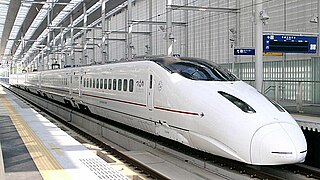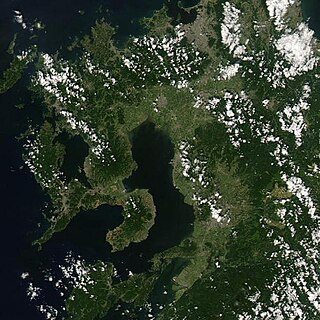
Amakusa (天草), which means "Heaven's Grass," is a series of islands off the west coast of Kyushu, the southernmost of the four main islands of Japan.

Kyushu is the third largest island of Japan and most southwesterly of its four main islands. Its alternative ancient names include Kyūkoku (九国, "Nine Countries"), Chinzei (鎮西, "West of the Pacified Area"), and Tsukushi-no-shima (筑紫島, "Island of Tsukushi"). The historical regional name Saikaidō referred to Kyushu and its surrounding islands.

Kumamoto Prefecture is a prefecture of Japan located on the island of Kyushu. The capital is the city of Kumamoto.

The Kyushu Shinkansen is a Japanese high-speed railway line between the cities of Fukuoka and Kagoshima in Kyushu, running parallel to the existing Kagoshima Main Line and operated by JR Kyushu. It is an extension of the Sanyo Shinkansen from Honshu. The southern 127 km (79 mi) was constructed first because the equivalent section of the former Kagoshima Main Line is single track, and thus a significant improvement in transit time was gained when this dual track section opened on 13 March 2004, despite the need for passengers to change to a Relay Tsubame narrow gauge train at Shin-Yatsushiro for the remainder of the journey to Hakata. The northern 130 km (81 mi) section opened on 12 March 2011, enabling through-services to Shin-Osaka.

Minamata is a small factory town. Minamata Bay is a bay on the west coast of Kyūshū island, located in Kumamoto Prefecture, Japan. The bay is part of the larger Shiranui Sea which is sandwiched between the coast of the Kyūshū mainland and the off-lying islands of Kumamoto and Nagasaki prefectures.

Shin-Yatsushiro Station is a railway station in Yatsushiro, Kumamoto Prefecture, Japan, operated by Kyushu Railway Company.

Sasebo Station is the major railway station in the city of Sasebo, Nagasaki Prefecture, in Japan. The Sasebo Line of the Kyushu Railway Company and the Nishi-Kyūshū Line of the Matsuura Railway provide local and regional service and connections to the extensive JR network. Sasebo is the westernmost station in the JR Group.

RapiCa is a rechargeable contactless smart card ticketing system for public transport in Kagoshima, Japan, introduced by Kagoshima City Transportation Bureau, Nangoku Kōtsū, and JR Kyūshū Bus, from April 1, 2005. The name is the acronym of Rapid and Pay Intelligent Card. Just like JR East's Suica or JR West's ICOCA, the card uses RFID technology developed by Sony corporation known as FeliCa. The card is usable in all the tramway lines of Kagoshima City Transportation Bureau, as well as most bus lines of the three operators.

The Ariake Sea is a body of salt water surrounded by Fukuoka, Saga, Nagasaki, and Kumamoto Prefectures, all of which lie on the island of Kyūshū in Japan. It is the largest bay in Kyūshū. Its deepest point is only about 50 m deep, and extreme tides exceed 4 m, covering roughly 1,700 km2. It is used for aquaculture, with nori being a major product. Various species of fauna, including mudskippers, pen shells, and fiddler crabs, live in the Ariake Sea. In autumn, there is red-grass along the sea shore.
Recent years have brought increasing pollution, with resultant red tides. Isahaya Bay is a branch of the Ariake Sea. Across the Amakusa Islands lies the Yatsushiro Sea. There is ongoing land reclamation as evidenced by satellite despite government attempts to dissuade farmers from carrying out the activity.

Nagasaki Station is a railway station in Nagasaki, Nagasaki Prefecture, Japan, operated by the Kyushu Railway Company. It is the terminus of the Nagasaki Main Line.

The Mt. Aso Ropeway is Japanese aerial lift line in Aso, Kumamoto, operated by Kyūshū Sankō Tourism . It was opened in 1958, and climbs Mount Aso. Its official website claims it was the first aerial lift in the world to be built on an active volcano.

Kumamoto Station is the main railway terminal of the city of Kumamoto, Japan. It is located in Nishi-ku, Kumamoto, and is operated by Kyushu Railway Company.

Isahaya Station is a railway station in Eishō-chō, Isahaya, Nagasaki, Japan. It is owned by Kyushu Railway Company, and is the junction between three lines: the Nagasaki Main Line, Ōmura Line and the private Shimabara Railway Line.

Kami-Kumamoto Station is a railway station in Nishi-ku, Kumamoto, Japan. It is on the Kagoshima Main Line of JR Kyushu and the Kikuchi Line of Kumamoto Electric Railway. In front of the station is a tram stop of the tram operated by Kumamoto City Transportation Bureau named Kami-Kumamoto-Ekimae Station.

Usuki Station is a railway station in the Usuki area of the city of Kagoshima, Kagoshima Prefecture, Japan. The station is on the Ibusuki Makurazaki Line of the Kyushu Railway Company.

Amakusa Airfield (天草飛行場) is an airport located 2.3 NM northwest of Amakusa, Kumamoto, Japan, on the Amakusa Islands. Locals often referred to the airfield as Amakusa Airport. It is located on the northern side of the Amakusa Islands, north west of Amakusa city. Only one airline, Amakusa Airlines, uses this airfield, in which the airline is headquartered.

Matsuura Station is the railway station in Shisa-cho Ura-men, Matsuura, Nagasaki Prefecture.It is operated by Matsuura Railway and is on the Nishi-Kyūshū Line.

Emukae-Shikamachi Station is the railway station in Shimamachi-chō Fukae-men, Sasebo, Nagasaki Prefecture.It is operated by Matsuura Railway and is on the Nishi-Kyūshū Line.
Tairoin Hospital is a hospital for leprosy patients initiated by Jean Marie Corre (1850–1911) in Shimasaki Machi Kumamoto shi, Kumamoto Prefecture, Japan, in 1898, initially hospitalizing patients who gathered around Honmyoji Temple. He was a member of M.E.P. or "Missions Etrangères de Paris". The hospital started with the arrival of 5 sisters from the "Franciscan Missionaries of Mary" in 1898. The name of the hospital was changed to Biwazaki Tairo Hospital in 1952, and then to Tairo Clinic in 1996. The number of in-patients was 121 in 1948, and was 8 in 2008.




























